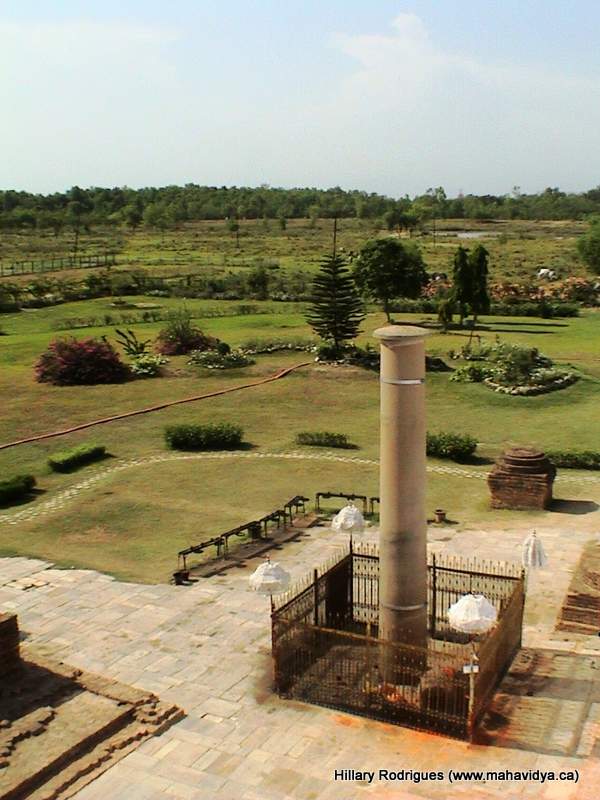The Rashtrakuta dynasty ruled over large portions of India from the 8th to 12th century. India at the time was under the threat of invasion from the Arabs, who conquered Sind in 712 (Thapar 2002:407) and were looking to expand to the west and control trade routes in the region. A royal family called the Calukyas controlled this territory and successfully resisted Arab attacks. This significantly weakened their power though. Seeing an opportunity an official in the Calukyas’ administration named Dantidurga declared his independence in 753 (Thapar 2002:334). The dynasty that he and his family formed the core of was called the Rashtrakuta, with their capital based in Ellora. After Dantidurga came Krsna 1, who was responsible for starting construction of Kailasa temple at Ellora in the late 8th century (Majunder 244). This rock-temple was entirely out of a hillside to represent Mt. Kailasa, which is a mountain in the Himalayas said to be the home of Vishnu. The physical dimensions of Kailasa are staggering. It is estimated to be 109 feet wide and 164 feet deep with over 200 000 tons of rock excavated in its creation (Smith 38).

This dynasty had the advantage of geographically situated nearly in the middle of India along the top of the Deccan Plateau (Robb 57). This position afforded many opportunities for expansion. The Rashtrakutas took advantage of this and frequently interfered with both the northern and southern kingdoms of India. The northern kingdoms were particularly easy to prey on, as there was no one powerful enough to effectively repel the Rashtrakutas.
The Rashtrakutas also controlled large portions of the western coast of India. The majority of the trade with West Asia came through these ports and much of the Rashtrakutas wealth along with it. Tea and cotton textiles were exported out of the kingdom and horses were imported to be sold further inland (Thapar 2002:408). The Rashtrakutas under Amoghavarsha also maintained good relations with the Arabs in Sind and traded extensively with them. Amoghavarsha was one of the longest-reigning kings in India (ruled from 815-877) and also one of the most powerful. His power was so great he was acknowledged as one of the greatest monarchs in the world along with the Caliph of Baghdad, Emperor of China, and the Emperor of Rome (Smith 216). He was favorable to the Jain religion, and may have been partially responsible for its rise in popularity, along with the decline in Buddhism (Robb 52).
A major focus of the Rashtrakuta dynasty was the control of Kanauj. This northern city was a hub of trade routes heading both east and south. It has been viewed as a symbol of power in northern India since the post-Gupta period (Thapar 1966:406). The Rashtrakuta, Pratihara, and Pala were all kingdoms focused on controlling this city, with the Rashtrakutas doing so on two occasions. One of these conquests came in 916 when Indra III captured the capital from Mahipala. Indra III was unable to control the city for long however (Smith 204).
By the end of the 10th century the geographical advantages the Rashtrakutas had enjoyed turned to disadvantages, as new powers in the north and south emerged as threats. In the south Deccan the Colas were becoming the dominant kingdom in the area (Thapar 1966:364). The Calukya dynasty, whom the Rashtrakutas had originally overthrown, was regaining much of their former power and territory. With this new threat in the south the Rashtrakutas were unable to keep the Colas from regaining their northern territories. Along with the threat of these two kingdoms was the rise of the Shilaharas in the north-western Decca. They took over much of the western coast and port cities of Western India. This power was so absolute that the Shilaharas gave themselves the title of “Lords of the West” (Thapar 2002:369) in reference to their control over trade in the region. In the end the Rashtrakuta’s dynasty came full circle and was overthrown by the Calukyas that Dantidurga had claimed independence from hundreds of years ago.
References and Recommended Further Reading
Datta, Kalinkar,. Majunder, R.C,.and Raychaudhuri, H.C. (1967) An Advanced History of India. New York: St. Martin’s Press
Smith, G.E. Kidder (1990) Looking at Architecture. New York: Harry Abrams
Thapar, Romila (1996) A History of India Vol 1. Baltimore: Penguin Books
Thapar, Romila(2002) Early India: From Origins to AD 1300. Berkley: University of California Press
Vincent, Smith (1981) The Oxford History of India 4th Edition. Delhi: Oxford University Press
Wolpert, Stanley (1997) A New History of India 5th Edition. New York: Oxford University Press
Related Topics
Sind
Arabs in India
Kanauj
Trade Routes
Deccan Plateau
Ellora
Shilaharas
Calukya Dynasty
Pala Dynasty
Pratihara Dynasty
Related Websites
http://whc.unesco.org/en/list/243
http://asi.nic.in/asi_monu_whs_ellora.asp
http://www.greatbuuildings.com/buildings/Kailasa_Temple.html
http://www.tourism-of-india.com/deccan-plateau.html
http://en.encyclopedia.jrank.org/JUN_KHA/KANAUJ.html
http://en.wikipedia.org/wiki/Rashtrakuta
http://www.answers.com/topic/sind
Written by Scott Wong (Spring 2009), who is solely responsible for its content.








